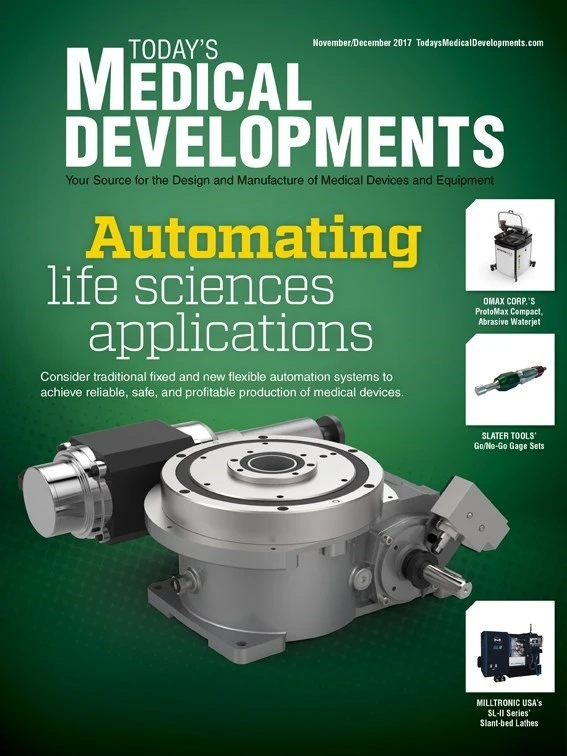
A crucial design step for any major piece of equipment is the alpha prototype, a proof-of-concept used before the item is ready for production. Engineers at Gatan Inc. have designed an alpha prototype of its next-generation automated specimen preparation tool mounted directly to a scanning electron microscope (SEM).
The IPrep alpha prototype shuttles a sample back and forth between the processing chamber and a receiving dock on the SEM. Two broad-beam ion guns polish the sample at low angles in the processing chamber, a design based on Gatan’s Precision Etching and Coating system (PECS).
Broad-beam ion polishing allows for sample preparation of large flat areas (about 300µm) with very low surface damage, enabling microscopists to use a range of techniques on a wide variety of samples.
Incorporating an automated transfer mechanism allows IPrep users to take advantage of SEM-related imaging techniques such as electron back scatter diffraction (EBSD) and energy-dispersive X-ray spectroscopy (EDS) to mill away 1nm to 100nm from the surface of the sample. These techniques image and remove the top surface to create a new top surface, resulting in a 3D reconstruction of specific areas of the sample with a high level of slice thickness control.
System design
Gatan engineers designed and fabricated the IPrep system using key third-party suppliers for individual components such as motors, controllers, vacuum parts, actuators, and sensors. The IPrep uses two AllMotion controllers – one commands the end-effector of a transfer arm, picking up and dropping off the sample carrier at two locations, the polishing chamber, and the SEM; and another for the kinematic mounting system on the receiving dock inside the SEM. Stepper motors used for the end-effector and receiving dock, made by two different manufacturers, still allow the AllMotion controllers to be implemented.
The 2.25" square controllers are fully intelligent with drivers that can be bolted to the back of the stepper motor they control. A single four-wire bus contains two power wires and two communication wires. Commands are made via any serial terminal program or from the EZStepper Windows application.
Thijs Hosman, project manager and research scientist for Gatan says, “I like the extreme versatility that the AllMotion controllers provide. I found it easy to use them for very different applications, each having a wide variety of motors and sensors connected to them. They are extremely easy to reprogram and interface. Plus, they easily daisy-chain (for up to 16 similar controllers) and use a simple-to-implement serial protocol or EZStepper Windows application.”
This is particularly important because Gatan uses multiple manufacturers’ products on the IPrep depending on the operational requirements.
“We needed a system that could move large distances (up to 1m) reliably and in a repeatable way,” Hosman says.

Reliability, repeatability
Since every operation the IPrep performs occurs in a vacuum chamber, it is impossible to hear or see when things go wrong. To understand a problem halting workflow, engineers chose EZHR23EN48V sensors pre-wired for OptoSwitch inputs.
Repeatability of placement in the SEM is crucial, so reliable, accurate components are key requirements for the system. The 3D reconstruction only works with very low shift and rotation between placements, with tolerance for shift between images in the SEM (after transferring) within nanometers. While some of the shift between images can be compensated for by incorporating shift-detection algorithms, mechanical placement accuracy still must be within 1µm. The tolerance for rotation is about 0.05° between images, and the distance between the preparation chamber and the SEM is 1m.
Ensuring the high-vacuum E-6/Torr compatible receiving dock with a kinematic mechanism that could repeatedly mount samples with an accuracy of <1µm was one challenge designers faced. Another challenge was addressing a workflow with very specific operations that all must be handled reliably thousands of times. So, as with any design, product design involved tradeoffs. Time versus accuracy, speed versus reliability, and in the case of stepper motors, speed versus torque. Engineers focused on reliability. Focus for the next version will be on easier operation with a friendlier user interface.
Product operation assumes the user is familiar with SEM and ion polishing as a preparation technique. The IPrep itself has a user interface within the Gatan Microscopy Suite (GMS), so operation is automatic after setting up the parameters for polishing and imaging.
While some controls are still basic, engineers continue to collect user data for more insight into the workflow and controls for an easier user interface.
AllMotion Inc.
www.allmotion.com
Gatan Inc.
www.Gatan.com
Get curated news on YOUR industry.
Enter your email to receive our newsletters.
Explore the November December 2017 Issue
Check out more from this issue and find your next story to read.
Latest from Today's Medical Developments
- Siemens accelerates path toward AI-driven industries through innovation and partnerships
- REGO-FIX’s ForceMaster and powRgrip product lines
- Roundup of some news hires around the manufacturing industry
- Mazak’s INTEGREX j-Series NEO Machines
- The Association for Advancing Automation (A3) releases vision for a U.S. national robotics strategy
- Mitutoyo America’s SJ-220 Surftest
- #56 - Manufacturing Matters - How Robotics and Automation are Transforming Manufacturing
- STUDER looks back on a solid 2024 financial year





